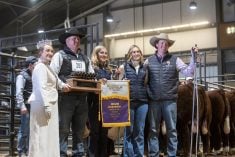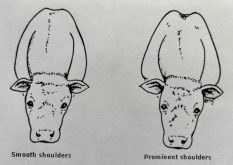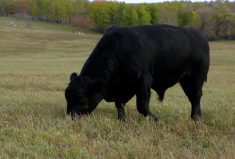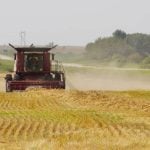The hardest time for a young bull is when he’s turned out with cows for his first breeding season, after being well fed all winter. Most bulls are raised in unnatural conditions. After weaning they are confined and often fed high-concentrate feeds, and pushed for fast growth. Many go through a bull test/feeding program to measure rate of gain and feed efficiency, and are overly fat. And while most stockmen know that fat is unhealthy for a bull, they still tend to buy the biggest, best-looking animals, and many breeders keep overfeeding young bulls because it’s harder to sell a bull that wasn’t pushed for faster gain.
Read Also

Canadian Beef Check-Off Agency reports on investments and activities
The check-off agency’s work behind the scenes is what ensures cattle check-off dollars are invested wisely, accounted for transparently and deliver measurable value back to producers and importers.
These overfed bulls need to be let down slowly, and some don’t transition very well to more workmanlike rations. They may not be as fertile if they have too much fat in the scrotum and may not hold up, since hot rations can cause permanent damage to their feet. Bulls must be athletic and have the ability to stay sound, with endurance to cover a lot of territory and a lot of cows. Overfeeding can permanently impair that ability.
Even bulls developed on growing rations are usually carrying more flesh than bulls raised on grass or wintered on hay.
It also pays to have a good transitioning programs after you bring a bull home. Its success will depend in part on how long you have him before he goes out with cows. Some ranchers buy bulls in the fall or winter, giving them plenty of time to adjust to the new environment. On the other extreme are those who bring bulls home a few days or weeks before turnout.
Some seedstock producers offer wintering program for fall-bought bulls delivering them closer to breeding season. This works if they can rely on the breeder to have the bulls in ideal working condition at the time of delivery.
Avoid fat
“When we were buying bulls, this was one of the criteria we used when looking at the herd average. I would usually pick one of the fatter bulls within the group because I want easy-fleshing cattle that do well on feed, and their daughters will hold their flesh and body condition. But if a herd averaged 0.3 inch of backfat on their ultrasound scan data I wouldn’t bother to look at their bulls,” says Olson.
“Some bulls offered for sale have as much as 0.45 inch of backfat. That’s too much for bulls. If they are like that when they are 14 months old — at a March sale for January-born calves — this is equivalent to a finished steer,” he says.
“A young bull with this much fat may have liver failure, his feet may fall apart, and there’s more weight and stress on bones and joints. Fat bulls are more likely to put a hip out of place or have some other kind of breakdown. Even humans that are obese have problems reproducing,” he says.
“As many as one-third of over-fat bulls will not be able to freeze semen. Bull studs will tell you that they have a problem with overfat bulls. Those bulls might narrowly pass the semen test for breeding cows, but don’t have adequate quality to freeze the semen,” he explains.
Reproductive specialist John Kastelic, DVM, PhD with the department of production animal health, University of Calgary says there is good evidence to show that if you feed bulls high-energy diets after weaning, you get very rapid weight gain but also create problems with excessive fat in the scrotum, reduction in semen quality, more risk for laminitis/founder, liver abscesses, rumenitis, etc.
“It is very detrimental to feed bulls high-energy rations post-weaning for rapid gains. The thinking used to be that if a bull is not fat he must be a hard keeper. Sale bulls were always fat but producers thought they could just take them home and put them on a diet before going out with cows and then they would be in breeding shape. Unfortunately, some of the damage in the overfat young bull can be permanent,” says Kastelic.
Get them there soon
When you stress a bull you suppress the luteinizing hormone and it drops, taking testosterone down with it. With relocation there will always be some stress and decrease in semen quality. How long the decrease in semen quality persists will depend on how anxious the bull is, how long the trip is, etc.
“If you bring a yearling bull to a new farm and stick him in a pen with some mature bulls and he gets beat up, he may have issues with semen quality for six weeks or more. With any kind of stress you’ll see abnormal sperm in about 10 days and it may take three to six weeks for semen to get back to normal, depending on how stressed he was and how severe the changes are. He needs time for the transition,” says Kastelic.
Olson advises getting bulls home as soon as you can. “Many ranchers leave them at the feedlot longer so they don’t have to worry about the bulls until closer to breeding season, but that’s not a good idea. How much are you really saving, to have the breeder keep a bull until closer to breeding season? Many breeders give a discount when you pick them up soon after the sale. They might take a month to deliver the bull, which might cost $2.50 per day for the feed. The number of bulls you might lose in the breeding pasture to poor adjustment or injury when they are not transitioned ahead of time to your environment makes it well worth picking them up sooner,” he explains.
“You can get the bulls adjusted to your feed, your grass, your environment. Many people buy bulls a long ways away. There’s a big difference between the climate at Lethbridge and the climate at Athabasca. Ranchers in Ontario often buy bulls in Alberta. It’s quite a change and the bulls need time to adjust.
“What we used to do when buying bulls was get them home as quickly as we could, and turn them out with our other bulls,” he says. Most people put their new bulls in a separate pen from their other bulls because they don’t want them to fight. They don’t put them together until turnout with the cows. Then they fight, and may get hurt. Olson prefers to let them get the fighting done and pecking order established.
“It’s good to get that out of the way. Even though putting the new bulls in a little corral until you turn them out with cows is easier on your corrals, and easier on the bulls in the short term, it’s not the best thing for those bulls,” says Olson.
“You are far better off to get the pecking order established well ahead of when they go out with cows. Some people disagree with me, but if a bull is going to get injured fighting it’s good to know he’s been lost for the breeding season — well before you are down to slim pickings to replace him in June or July. If you simply turn them out with the cows and the bulls have a war because they haven’t established their pecking order, and a bull gets injured, there’s not a lot of selection left by that time at most breeding farms. Most injuries will happen right when you turn them out with cows, if those bulls have never been together before,” he says.
“It’s also important to give bulls a lot of space. Even if we have 50 bulls together, we never have them in a pasture smaller than 40 acres. They need room to roam, and get away from each other. If you get new bulls in the winter, put them in a big area but bed them in several locations. Then the bulls that take a licking can go off somewhere else. Bulls in proper condition and not overfat are less likely to get hurt. Bulls that are packing more weight are less athletic and more likely to be seriously injured,” Olson says.
Transition takes time
“If the bull is stressed during transport and/or takes a beating when he arrives at your place and has to fight other bulls, or gets pushed away from the feed bunk because the other bulls are beating him up — and he goes off and doesn’t eat for several days — the stress from all this can affect semen development,” says Olson.
This is a good reason to have all of this accomplished more than 60 days ahead of the breeding season.
A bull that’s really fat and then loses weight swiftly (as when a young fat bull is turned out with the cows and falls apart) won’t be fertile through the breeding season. “Losing weight is a stress. Many yearling bulls lose as much as 400 pounds their first breeding season, and that’s very unhealthy,” Olson says.
“If a bull loses this much weight there’s usually something wrong with how the breeder developed the bull, or genetically wrong. A bull should be able to breed and still look decent, and you can help him out by the way you transition him. Bulls should be vaccinated before breeding season, and we also like to give our bulls vaccinations for pinkeye and foot rot before they go out with the cows. Many people vaccinate their cows and don’t think about vaccinating the bulls, but that’s an important part of their health program. They also need minerals and not just a salt block.”
“If you are feeding a total mixed ration, make sure minerals are included. Everything we can do to promote the health of these bulls is very important,” he says.
Kastelic stresses the importance of exercise. “Don’t have bulls in a little pen. Producers often winter their bulls in small pens with robust fences, and then turn them out with cows into several sections of pasture, which is a huge transition,” he says.
“They’d be better off kept in a larger lot where they had to walk from the feed to the water, to create some forced exercise. All too often the producer brings home an expensive bull and puts him in a small pen to protect him from injury, and when he goes out to work, he is not ready for it.”
















